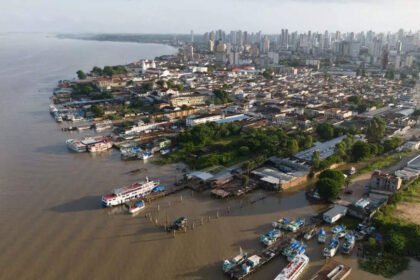TL;DR:
Saudi Arabia imports sand from nations such as China and Australia to meet construction standards for mega projects.-
Desert sand is unsuitable for concrete due to its fine, rounded texture. - The Kingdom’s
Vision 2030 projects are driving the demand forconstruction-grade sand . - The
global sand shortage , highlighted by the UNEP, is a growing concern with sustainability efforts in progress.
It may sound ironic, but Saudi Arabia, known for its expansive deserts has long been importing sand from abroad, notably from Australia, China and Belgium as per the OEC. While the idea of a desert nation buying sand seems puzzling, the reason is rooted in the specifics of construction requirements. As the Kingdom races ahead with its multi-billion dollar Vision 2030 projects, the demand for a specific type of sand that deserts can’t provide has led to a steady stream of imports. This lesser-known fact sheds light on a broader global issue: the growing scarcity of construction-grade sand and the paradoxes of resource dependency even in the most unlikely places.
Why Desert Sand Won’t Do
Desert landscapes like Saudi Arabia’s might be abundant in sand, but not all sand is created equal. The grains found in deserts are typically too round and smooth because they have been eroded by wind over thousands of years. This makes them poorly suited for concrete production, where angular and coarse grains are essential to form a strong, cohesive mix when combined with cement and water. The type of sand required for skyscrapers, infrastructure, and urban development usually comes from riverbeds, lakes, and seabeds, environments that produce more angular grains capable of binding effectively. According to the United Nations Environment Programme (UNEP), the world consumes around 50 billion tonnes of sand annually, making it the most extracted solid material globally. However, only a fraction of this is suitable for construction purposes.
Australia’s Role in Supplying Sand
Australia has emerged as one of the key exporters of high-quality silica and construction sand. As per the OEC world, in 2023, Australia exported $273M of Sand, making it the 2nd largest exporter of Sand (out of 183) in the world with Saudi Arabia among the importers. In 2023, Saudi Arabia imported about US $140,000 worth of natural construction-grade sand from Australia.Saudi Arabia’s purchase of Australian sand, highlights the Kingdom’s reliance on these imports to meet construction standards for mega infrastructure projects. The conversation resurfaced on social media in 2024, the trend continues in the wake of Saudi Arabia’s ambitious urban development plans, including NEOM, The Red Sea Project, and Qiddiya. These projects require not just vast amounts of concrete but also the highest standards in material quality, a demand that desert sand simply cannot fulfil.
The Broader Gulf Context
Saudi Arabia isn’t alone in this phenomenon. Other Gulf countries such as the UAE and Qatar also import sand for similar reasons. The UAE, particularly Dubai and Abu Dhabi, sources construction-grade sand internationally to fuel its relentless skyline expansion. A UNEP 2024 policy brief reinforced that the Middle East’s rapid urbanization is contributing to rising global demand for construction sand, with regional countries increasingly looking to sustainable solutions but still dependent on imports for the near term.
A Global Sand Crisis
The dependence on imported sand is not just a Saudi issue; it reflects a growing global concern. The UNEP has flagged that the world is facing a “sand crisis,” warning that unregulated sand extraction is leading to environmental degradation in many parts of the world, including riverbed erosion, habitat destruction, and loss of biodiversity. In response, some countries are investing in alternatives like manufactured sand (M-sand), made by crushing rocks to create suitable construction material. Additionally, recycled construction waste is being repurposed to alleviate pressure on natural sand resources. Saudi Arabia, too, is exploring these options. While there’s no comprehensive national policy yet on reducing sand imports, experts suggest that innovation in materials science could eventually help the Kingdom lessen its reliance on foreign sand.
Vision 2030 and the Need for Quality
Saudi Arabia’s Vision 2030, a blueprint to diversify the Kingdom’s economy beyond oil is driving massive infrastructure developments. The $500 billion NEOM city, the futuristic The Line urban concept, and other mega-projects require specialised building materials that meet international standards. Thus, importing industrial-grade sand isn’t just a matter of preference but a necessity. Without it, the construction of ultra-modern facilities, smart cities, and tourism hubs would face material shortages or quality compromises.
Are There Sustainable Solutions Ahead?
The focus is slowly shifting towards sustainability and resource management. Saudi Arabia’s broader environmental strategies under Vision 2030, which include renewable energy targets and waste management reforms, may eventually extend to sand use as well. Research into M-sand and alternative aggregates is underway in academic institutions within the Kingdom, aimed at reducing the environmental footprint of construction. However, widespread adoption will take time, given the massive scale and immediate material requirements of ongoing projects.What seems like an amusing paradox, a desert nation importing sand actually reflects deeper realities of modern construction, resource management, and global trade. Saudi Arabia’s sand imports from Australia and other nations such as China and Belgium underscore the importance of material specificity in infrastructure, even in the heart of the desert. As the Kingdom races toward its Vision 2030 goals, balancing resource demand with environmental sustainability will remain critical. For now, though, the shipments of sand from various nations continue to play a surprisingly essential role in building Saudi Arabia’s future.






